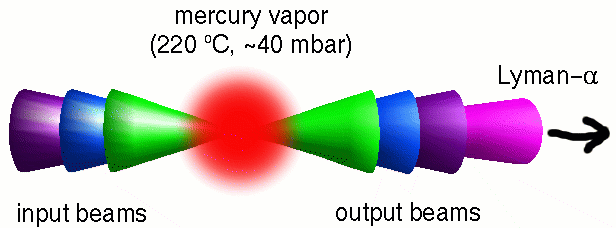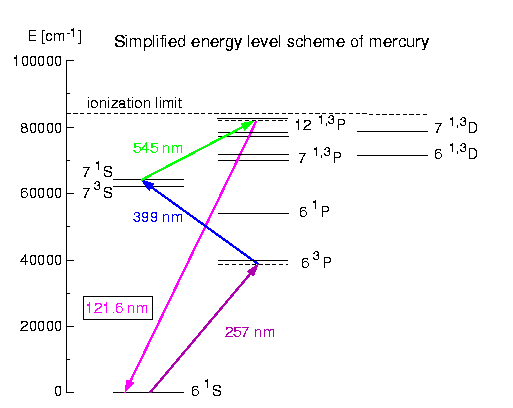| Max-Planck-Institut für Quantenoptik (MPQ) | Laser Spectroscopy Group Home |
|
|
Overview |
Introduction |
Antihydrogen production |
Antihydrogen spectroscopy |
Experiment: 'CW-Lyman-alpha' |
The most simple source of Lyman-alpha is a hydrogen lamp.
However, the broad spectrum of these lamps (~ 30 GHz) render them fairly
useless for laser cooling. So far the best sources of narrow bandwidth
Lyman-alpha have been based on high power pulsed lasers and non-linear
optical processes. With such a source laser cooling to 8 mK of magnetically
trapped hydrogen has been successfully demonstrated in Amsterdam [1]. The
most ideal source of Lyman-alpha would have the following characteristics:
Such a continuous source would open several new possibilities.
For one thing, it should be able to reach the cooling Doppler limit of
~ 3mK. Also, the narrow bandwidth results in an excellent state selectivity
such that the chance of exciting the wrong (not-trapped) magnetic sublevels
is minimized. When powerful enough (at least 1012 photons/s),
Zeeman-slowing antihydrogen into a magnetic trap becomes feasible.
Another possibility is using 1S-2P transition fluorescence to detect a
1S-2S transition events. This can be done by 'shelving spectroscopy':
if the atom is in the 2S, it cannot scatter Lyman-alpha anymore. A transition
1S-2S is then detectable by looking for Lyman-alpha fluorescence dips.
With these advantages in mind we have developed
the first continuous, coherent, Lyman-alpha source in the world [2].
Our source is based on four-wave-mixing. In this process three different
laser beams are focused in the same volume of a mercury vapor oven.
Due to the high intensity laser beams, the electrons in mercury start to
oscillate in a anharmonic way. As a result a little bit of light is generated
at the sum frequency of the three incoming laser beams:

To appreciate the difficulty of generating continuous
wave Lyman-alpha, one has to realize that the yield of the four-wave-mixing
process depends heavily on the power of the incoming laser beams:
Output power VUV = N2 * X2(3) * F * P1*P2*P3
where N=mercury density, X(3)=third order non-linear susceptibility, F=phasematching integral, and P1*P2*P3 is the product of the three input laser powers. Pulsed lasers have a peak power generally 7 orders of magnitude higher than that of typical continuous lasers. As a result it is far more easy to do pulsed four-wave-mixing as the factor P1*P2*P3 is more than 20 orders of magnitude larger!
Fortunately two aspects work in favor of four-wave-mixing
with continuous instead of pulsed lasers (with typically ns long pulses):

By choosing the wavelength close to resonances in the atom, one can increase the response of the electrons in mercury on the light by many orders of magnitude. The picture to the left shows a simplified energy diagram of mercury, and the different colors we use to generate Lyman-alpha light. Especially the exact two-photon resonance is vital to improve the efficiency of the process. Further yield improvement is accomplished by the near 1- and 3-photon resonances.
As a result continuous four-wave-mixing can still generate an appreciable amount of light. From ~ 500 mW at 257 nm, 700 mW at 399 nm, and 1.4 W at 545 nm, we have generated so far almost 1010 photons/s (~10nW) at 121.56 nm. It is already one of the stronger Lyman-alpha sources that have been built, and the only continuous coherent one. The energy conversion efficiency is 0.5*10-8. If light bulbs would be as inefficient as this we would need a bulb of 600 000 000 W to have the same amount of light as a standard 60W bulb generates! The highest yield we reached at 122 nm with almost 200 nW.
Although 10 nW at Lyman-alpha may not sound much, it is already enough to do effective laser cooling of antihydrogen.
A schematic of the experimental
setup is available here, together with a VUV yield curve.
References:
[1]: I.D. Setija et al., Phys. Rev. Lett. 70, 2257 (1993)
[2]: K.S.E. Eikema, J. Walz, and T.W. Hänsch, Phys. Rev. Lett.
83,
3828 (1999)